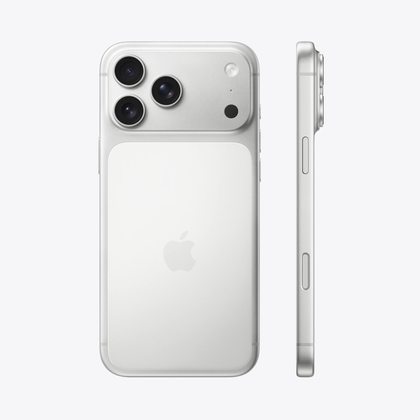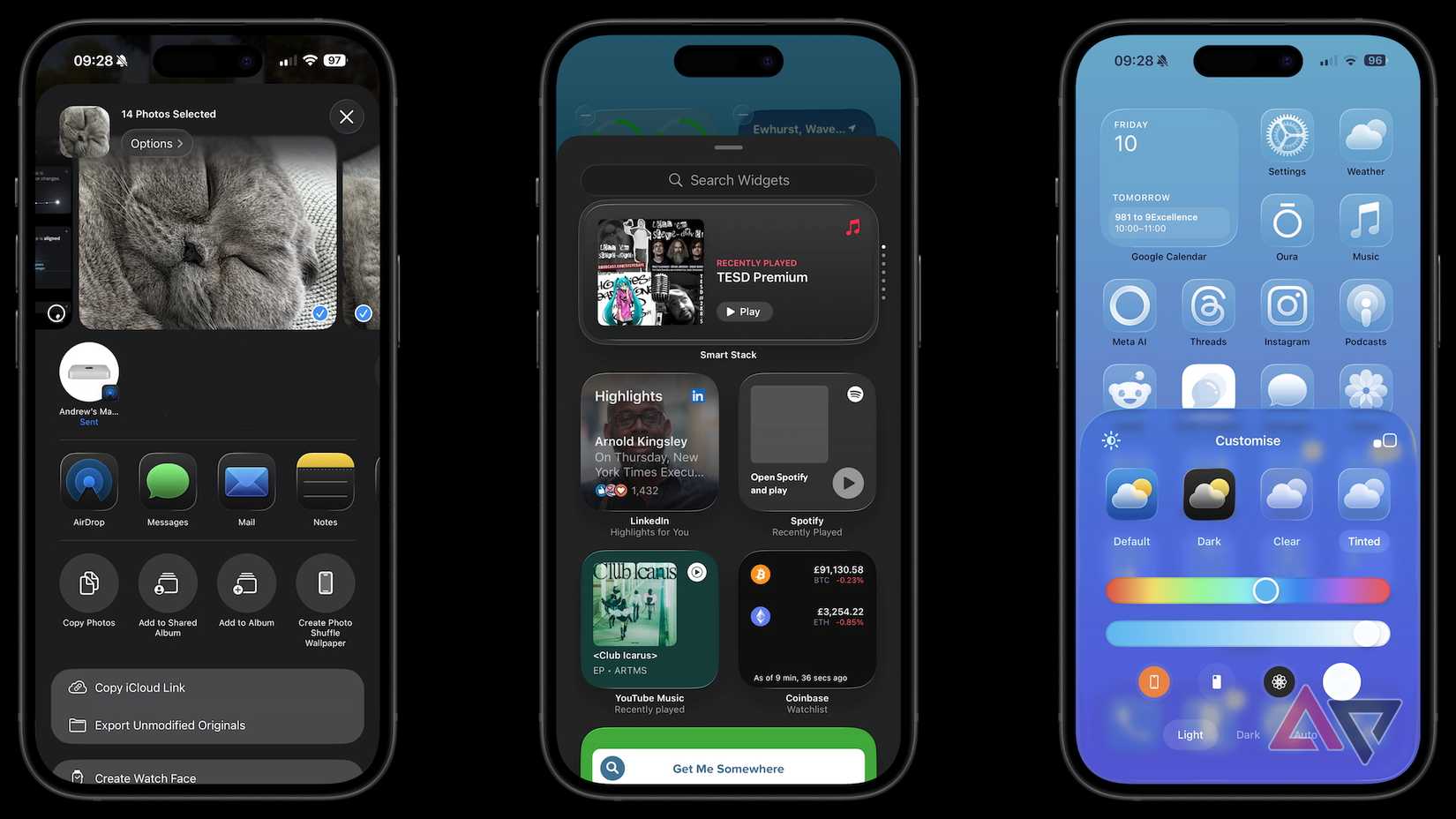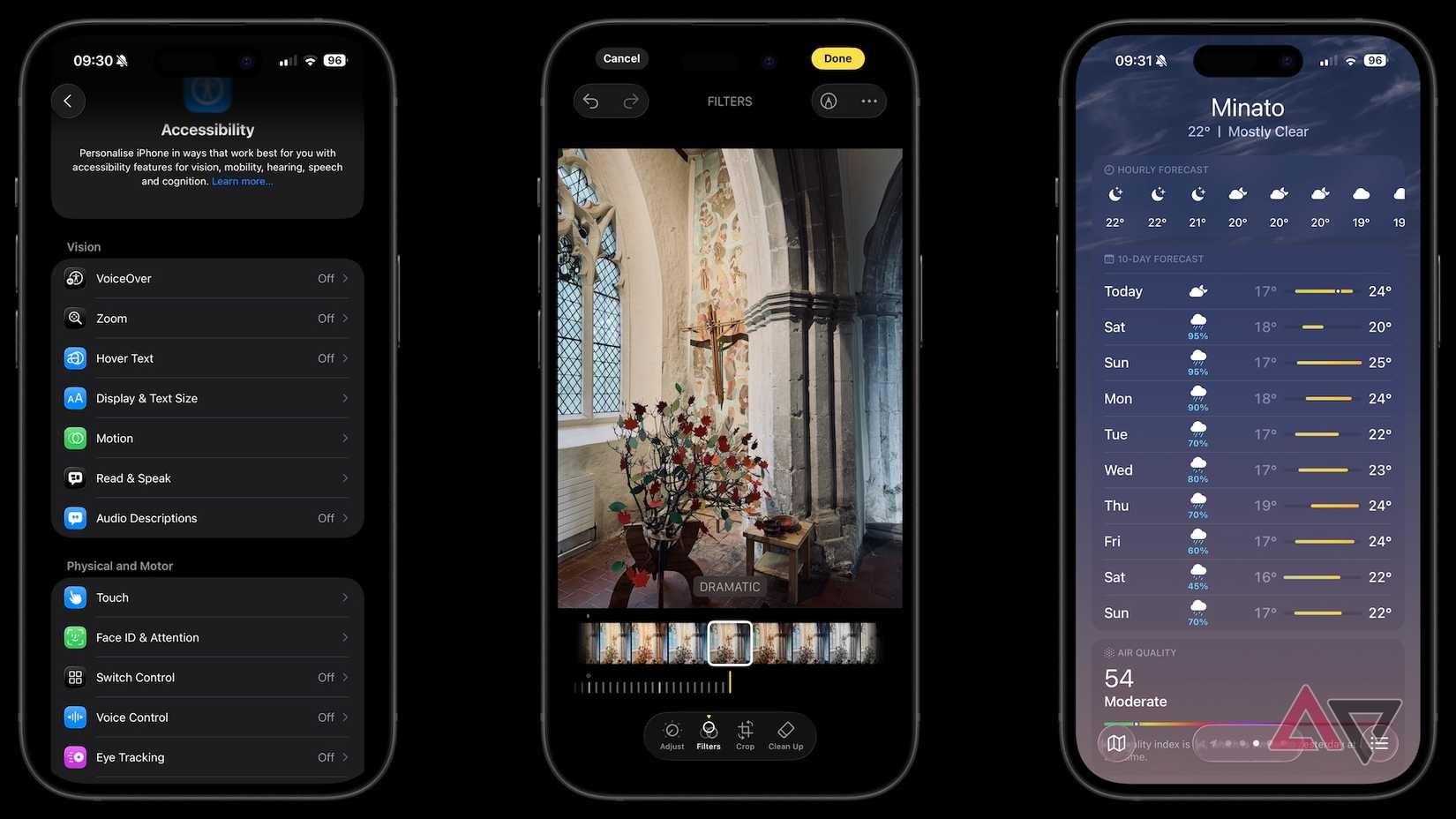Another year, another iPhone Pro Max model for the Android faithful to point at and say they’ve had this feature and that feature for years already, lament at how it doesn’t fold up, and generally ignore it, right?
Wrong. To do so is to willfully dismiss what is a superb phone, which, for the first time in a while, even has enough to make an annual Pro model upgrade genuinely worth considering. I’ve been using it for the last few weeks, and have been impressed, but crucially not always, as I’ll now explain.
Apple iPhone 17 Pro Max
- SoC
-
A19 Pro chip
- Storage
-
256GB, 512GB, 1TB, or 2TB
- Battery
-
Up to 39 hours of video playback
- Ports
-
USB-C
Did you look at the iPhone 17 Pro and think you needed something with a bigger screen, or more storage? The iPhone 17 Pro Max has you covered.
- Camera takes balanced, colorful photos
- New selfie camera with Center Stage
- Two-day battery life
- Many useful everyday features
- Fun new body colors
- Beautiful, smooth-scrolling screen
- iOS 26 is fraught with bugs and design issues
- Apple Intelligence lacks any compelling feature
- Camera doesn’t switch between lenses smoothly
Specs, price, and availability
The Apple iPhone 17 Pro Max differs in its price based on the amount of internal storage you choose. The base version has 256GB and costs $1,199, and it’s followed by a $1,399 512GB model, a $1,599 1TB phone, and finally a giant 2TB iPhone 17 Pro Max for an equally giant $1,999.
You can buy the iPhone 17 Pro Max directly from Apple online or in one of its retail stores, along with all major carriers, and a variety of other retailers too. If you want an iPhone, it shouldn’t be too hard to find one.
The 17 Pro Max starts at the same price as the 16 Pro Max and the 15 Pro Max, and has double the storage space of the slightly cheaper base model iPhone 14 Pro Max. This consistency is great to see. It’s a little cheaper than the base $1,299 Samsung Galaxy S25 Ultra, and the same price as the Google Pixel 10 Pro XL. If the 17 Pro Max’s 6.9-inch screen is too big, consider the 6.3-inch iPhone 17 Pro, which is otherwise the same phone.
Specifications
- SoC
-
A19 Pro chip
- Display type
-
Super Retina XDR display with 120Hz ProMotion
- Display dimensions
-
6.9-inches
- Display resolution
-
2868 x 1320
- Storage
-
256GB, 512GB, 1TB, or 2TB
- Battery
-
Up to 39 hours of video playback
- Charge options
-
Wired, MagSafe wireless
- Ports
-
USB-C
- Operating System
-
iOS 26
- Front camera
-
18MP
- Rear camera
-
48MP main, 48MP wide, 48MP telephoto
- Wi-Fi connectivity
-
Wi-Fi 7
- Bluetooth
-
Bluetooth 6
- Dimensions
-
163.4 x 78 x 8.75mm
- Weight
-
233 grams
- IP Rating
-
IP68
- Colors
-
Silver, Cosmic Orange, Deep Blue
New design will split opinion
Apple has abandoned the simple elegance of recent iPhone models, giving the 17 Pro an unexpectedly brutalist makeover, and also shunned titanium for aluminum for the 17 Pro series.
While it’s not a complete departure from previous iPhone Pro models, the iPhone 17 Pro Max does have a distinct new style, along with a choice of more interesting than usual colors.
The one in our photos is called Cosmic Orange, and it makes the phone as subtle as a big, orange sledgehammer, but you can choose a Deep Blue, silver, or white model if you prefer. That’s right, no ordinary black model. Daring stuff, and I mean that honestly.
If you’ve used a previous Pro Max model or a Samsung Ultra phone, then the 17 Pro Max will feel very familiar in your hand. It’s big because it has to house a 6.9-inch screen, it fills pockets and small bags, and is practically impossible to use with one hand. It’s the compromise you make with all large phones.
The body is slippery, and a case is recommended. Just don’t choose Apple’s clear case, because it barely provides any additional grip.
Apple’s Camera Control returns. It’s a physical button on the side of the phone used to change zoom levels, camera modes, and as a shutter release. I press it by accident more often than I do intentionally.
A side-mounted button on a large, heavy phone isn’t ergonomically sound, and it’s usually much easier to use the regular on-screen camera controls.
The iPhone 17 Pro Max has an IP68 dust and water resistance rating, and feels strong and substantial in your hand. However, if you don’t put it in a case, some owners are reporting how the body can pick up nicks and scratches, which in some scenarios can sink deep enough to expose the bare aluminum.
Apple has steadily introduced more ways to customize the look of iOS over the past few years, and you can tweak everything from widgets on the lock screen to the color and shading of the home screen icons, to placing apps in any position across multiple home screens.
Yes, I can hear you, Android phone owners, there’s no need to shout. From the design to the colors, and the multiple ways to change the look and operation of the software, the iPhone 17 Pro Max is the most personal iPhone yet.
In the same way many Android phone makers do things to appeal to iPhone owners, Apple is steadily doing the same for Android owners with the iPhone. Thankfully, none of it is in-your-face, and the iPhone faithful won’t feel ignored, as the essence of the iPhone and iOS remains.
Big camera improvements
Apple has been sleeping on its camera for a little while. I don’t feel like I’ve truly enjoyed an iPhone camera since the iPhone 12 or iPhone 13. They haven’t been bad, just not as good as the cameras on Android phones. That has all changed on the iPhone 17 Pro and iPhone 17 Pro Max, which share the same camera specs.
There are three 48-megapixel cameras on the back of the phone, and while Apple tells you it has 2x, 4x, 8x, and up to 40x zoom, only the 4x is an optical zoom, and the rest are optical quality. This doesn’t mean they’re terrible, but it’s better to be factual than not. When you get started with the camera, you’ll may spot an occasional delay when switching between cameras, resulting in a pixelated view on screen for a few moments.
One of the key improvements Apple has made is to tone down the high contrast levels and poor shadowy detail which has plagued its cameras for a while. The 17 Pro Max’s camera is far better balanced, with great dynamic range and realistic shadows. Sunny day photos are bright and punchy, without being overly vibrant, leaving space to edit if you want.
The 4x optical zoom takes crisp, sharp photos, while the 8x optical quality zoom isn’t far behind, with only a hint of smoothing in some scenarios. All the cameras have a consistent look, which seems to be a challenge for other brands to overcome, and I’ve had fun playing with the different Photographic Styles.
Unfortunately, the camera interface itself is a bit of a mess. What was once a minimal, but very quick and easy-to-use design, is now a less enjoyable, often multi-step irritation. For example, Apple’s Photographic Styles filters are hidden away, and instead of just showing the camera’s main mode switcher below the viewfinder, you have to press the Photo button to make them appear.
It’s all part of the iOS 26 redesign, and it can be a culture shock in general. Yes, you’ll get used to it, but I don’t think we “get used” to good software, we “get used” to poorly designed software. That said, I’ll forgive the slightly annoying app because the iPhone 17 Pro Max’s camera performance is much stronger than in previous years.
What about the new selfie camera?
The iPhone 17 Pro models have a new 18MP Center Stage front camera, and a couple of very cool features to go with it. The first got a lot of attention during the phone’s launch, and it allows you to hold the phone in either portrait or landscape, and still choose whether you want to shoot portrait or landscape selfies.
It sounds rather niche, but it provides way more flexibility in the way you hold the phone, then frame your stills or video. Anyone who uses the iPhone’s front camera for vlogs will appreciate the feature. It works really well, and is easy to override if you don’t need it. There’s also a zoom mode, and Dual Capture to shoot with both the front and rear cameras at the same time.
The other new feature is Center Stage, which we’ve previously seen on the Apple iPad. The front camera essentially tracks you during a video call, using the camera’s zoom, ensuring you stay in the frame. It’s not something you use, but rather something that happens, and it’s really effective. I’ve seen it in action during FaceTime calls, and the person I’m chatting to has been surprised to see the camera “follow” me as I moved around the kitchen.
What about iOS 26 and Liquid Glass?
Apple’s iOS 26 software manages to look and feel quite new, while also staying pretty much the same as always. The Liquid Glass design — shimmery, glassy, and flowing — can look pretty, and isn’t as intrusive as it could be, but it can cause various problems where it obscures buttons, or formats oddly over apps.
My problem is it doesn’t always look very modern, and once or twice, it has reminded me of those old Android launchers I’d quickly replace because they were just too overly designed. I personally prefer a simple design with easy access to the apps and features I use the most, and iOS usually excels at that, but unwanted complexity is creeping in.
I’ll sing the praises of the 6.9-inch Super Retina XDR display and its super smooth 120Hz ProMotion refresh rate, which is class leading. All my apps load immediately, the App Store is packed, and the entire experience is incredibly smooth. I’ve had no problem with performance, and even during the 3D Mark benchmarking app’s 20-minute intensive test, it didn’t become too hot to hold.
However, apps are still adapting to Liquid Glass and iOS 26, and several have some really annoying bugs and design choices. For example, Chrome now has a big, underused bar above the keyboard which takes up way too much screen while not adding a lot of value, and Instagram often hides the top buttons outside the screen area, especially if a Live Activity has been running.
There’s also a lot of additional complexity to actions. I’ve already mentioned the Camera app, but even taking a screenshot requires an additional step confirming where you want to save the screenshot before it actually saves. Why can’t it just save, and I can override if I want to? There’s no need to slow down such basic tasks this way.
How to sum all this up? During a chat with my colleague Stephen Radochia, we both said how much more often we were picking up a modern Android phone over the iPhone to quickly get things done. This is a significant change because it indicates Android is getting simpler, while iOS is getting more complex. It’s quite a turnaround, and perfectly sums up living with iOS 26.
How long does the iPhone 17 Pro Max’s battery last?
I haven’t worried about the iPhone 17 Pro Max’s battery at all. My everyday use is relatively modest, in that I don’t often play games, but can still rack up between three and four hours screen time using apps, email, video, music, podcast streaming, and navigation.
I don’t think I’ve seen less than 50% battery remaining with this use in a single day, between about 08:00 a.m. and midnight. It has also been connected to the Apple Watch Series 11 and the Oura Ring 4 during this time. The Apple A19 Pro chip and iOS 26 make an efficient pairing, with a 30-minute, 1440p video using just 2% of the battery.
It can be recharged using a USB C cable or MagSafe wireless charging, and Apple says a 40W charger will add 50% in 20 minutes, or 30 minutes if you use a 30W charger, and for me that represents a full day of use.
I haven’t worried about charging because I love iOS’s Standby Mode, where placing it on a MagSafe charger turns into a bedside clock. The display is highly customizable, but I appreciate its simplicity more. It turns off the display in a dark room, but illuminates to show the time when it senses movement.
Through this convenient, useful, and attractive wireless charging system and the battery’s long usage time, the iPhone 17 Pro Max’s battery life has been a non-issue. Outside hardcore gamers using the phone for hours on end, most should get two days from a single charge.
Anything else to know?
There’s a huge amount to the iPhone 17 Pro Max, and instead of trying to squeeze small details into other sections, here are a few important points to note about the phone, its performance, and software.
The default Weather app is excellent. Not only is it clean and fast, but it’s really informative, with key information displayed without having to navigate through different pages, or put up with ads or unnecessary data. I also like the weather alerts, mostly because they’re usually absolutely accurate. It’s the best weather app I’ve used on a phone.
I use the iPhone for music and podcasts, all managed in the Music app, and frequently buy music through iTunes. Controls are really simple, and usually all I need is a shuffle button, but most of all I like its reliability. However, it’s frustrating to manage music on the iPhone through a Mac, and Music does seem to be built around the assumption you’re streaming through Apple Music.
The Apple Watch is the best smartwatch you can buy, and the Apple Watch Series 11 works seamlessly with the iPhone 17 Pro Max. Over the past month, I’ve had total reliability from both devices, and no issues whatsoever. However, just like the Music, Podcasts and iTunes apps being two too many, I’d like to see Fitness and Heath integrated into one app for convenience.
Apple Pay has become my default payment method, and I can’t remember the last time I used my card or cash for normal purchases. It works immediately, requires no upkeep, and is activated simply using a double press of the power key and Face ID, which remains fast and always accurate.
Think I’ve forgotten to mention Apple Intelligence? Well, you’re right, because, for the most part, I never know it’s there or working. While Google and Samsung constantly push AI, Apple does the opposite, and in both situations I still rarely find a reason to use the features. Sometimes, Apple Intelligence will summarize notifications, or push priority notifications to the top of the list, but that’s about it. I could easily live without it.
The majority of the problems I’ve encountered with the iPhone 17 Pro Max are software related, and while they frustrate, I don’t think they should put you off the phone. Apple is one of the best at delivering regular software updates (one has already arrived during my review period), meaning there’s a greater chance issues will be fixed. Apple also supports its phones with software updates for around five years.
Finally, there has been talk of a speaker problem with the iPhone 17 series. I haven’t noticed any obvious issues, but will say the speakers have been tuned for depth and bass response more than many others. Play the same music on the Samsung Galaxy S24 Ultra, and it sounds a lot brighter. Crank the volume up and there’s some distortion, just as you’d expect, but nothing I’d say is notably worse than any other phone.
Should you buy the iPhone 17 Pro Max?
If you’re looking for a big, bold, powerful smartphone, the iPhone 17 Pro Max is a brilliant purchase, and between the long battery life and the camera improvements, there’s just enough here to consider upgrading from the iPhone 15 Pro Max and an iPhone 16 Pro Max too. I’ve come from an iPhone 16 Pro Max, and am pleased with the upgrade.
Apple’s iOS 26 software will take some getting used to, and I’d like to see most of the small issues fixed in the next major software update, as these represent the majority of the downsides. I’m also more aware of feature creep and increased complexity in iOS, which hurts its simplicity, and reduces my confidence in recommending an iPhone to “regular” non-techy people.
As I finish off my review, I’m left thinking about how the gap between Android and iOS has reduced, with each taking on elements of the other, resulting in platforms which are no longer dramatically different. It means if you own an Android phone and want to try an iPhone, now is a great time to do it. If the iPhone 17 series doesn’t appeal to you as an Apple fan, there are some stellar Android phones to try out, and you won’t feel entirely at sea with either when you start out.
Apple iPhone 17 Pro Max
- SoC
-
A19 Pro chip
- Display dimensions
-
6.9-inches
- Storage
-
256GB, 512GB, 1TB, or 2TB
- Battery
-
Up to 39 hours of video playback
The Apple iPhone 17 Pro Max succeeds with its long battery life, much improved camera, and beautiful screen. The software still needs work though.


















